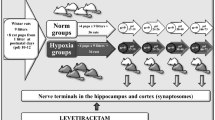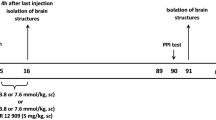Abstract
Carbachol-, norepinephrine- and glutamate-stimulated phosphoinositide metabolism was investigated in the neonatal, young and adult cerebral cortex slices of rats prenatally treated with methylazoxymethanol (MAM) on gestational day 15 (GD15) or GD19. In rat offspring treated on GD15 there was a significant reduction in the accumulation of [3H]inositol phosphates induced by carbachol and a significant increase in the accumulation of [3H]inositol phosphates induced by norepinephrine on day 7, whereas no changes were observed at the other ages. No significant changes, on the other hand, were observed for glutamate-stimulated phosphoinositide metabolism in GD15 treated rats and for carbachol-, norepinephrine- and glutamate-stimulated phosphoinositide metabolism in animals treated on GD19 at any of the different ages evaluated. These results indicate that treatment with MAM on GD15, which results in a marked microencephaly, causes a marked alteration of muscarinic and α1-adrenergic receptor-stimulated phosphoinositide metabolism during brain development and that these alterations undergo adaptive changes in the adult brain.
Similar content being viewed by others
References
Johnston, M. V., and Coyle, J. T. 1982. Cytotoxic lesions and the development of transmitter system. Trends Neurosci. 5:153–156.
Johnston, M., Carman, A. B., and Coyle, J. T. 1981. Effects of fetal treatment with methylazoxymethanol acetate at various gestational dates on the neurochemistry of the adult neocortex of the rat. J. Neurochem. 36:124–128.
Balduini, W., Cimino, M., Lombardelli, G., Abbracchio, M. P., Peruzzi, G., Cecchini, T., Gazzanelli, G. C., and Cattabeni, F. 1986. Microencephalic rats as a model for cognitive disorders. Clin. Neuropharm. 9:S8-S18.
Balduini, W., Lombardelli, G., Peruzzi, G., and Cattabeni, F. 1991. Treatment with methylazoxymethanol at different gestational days: physical, reflex development and spontaneous activity in the offspring. Neuro Toxicology. 12:179–188.
Balduini, W., Elsner, J., Lombardelli, G., Peruzzi, G., and Cattabeni, F. 1991. Treatment with methylazoxymethanol at different gestational days: two-way shuttle box avoidance and residential maze activity in rat offspring. Neuro Toxicology. 12:677–686.
Jonsson, G., Hallman, H. 1982. Effects of prenatal methylazoxymethanol treatment on the development of central monoamine neurons. Dev. Brain Res. 2, 513–530.
Balduini, W., Abbracchio, M. P., Lombardelli, G., and Cattabeni, F. 1984. Loss of intrinsic striatal neurons after methylazoxymethanol acetate treatment in pregnant rats. Dev. Brain Res. 15:133–136.
Johnston, M. V. and Coyle, J. T. 1980. Ontogeny of neurochemical markers for noradrenergic, GABAergic and cholinergic neurons in neocortex lesioned with methylazoxymethanol acetate. J. Neurochem. 34, 1429–1441.
Sanberg, P. R., Pevsner, J., Autuono, P. G., and Coyle, J. T. 1985. Fetal methylazoxymethanol acetate-induced lesions cause reductions in dopamine receptor-mediated catalepsy and stereotypy. Neuropharmacol. 11:1057–1062.
Beaulieu, M., and Coyle, J. T. 1982. Fetally-induced noradrenergic hyperinnervation of cerebral cortex results in persistent down-regulation of beta-receptors. Dev. Brain Res. 4:491–494.
Balduini, W., Lombardelli G., Peruzzi, G., and Cattabeni, F. 1992. Cholinergic hyperinnervation in the cerebral cortex of microencephalic rats does not result in muscarinic receptor down-regulation or in alteration of receptor-stimulated phosphoinositide metabolism. Neurochem. Res. 17:761–766.
Berridge, M. J., Downes, C. P. and Hanley, M. R. 1982. Lithium amplifies agonist-dependent phosphatidylinositol responses in brain and salivary glands. Biochem. J. 206:587–595.
Balduini, W., Murphy, S. D., and Costa, L. G. 1987. Developmental changes in muscarinic receptor-stimulated phosphoinositide metabolism in rat brain. J. Pharmacol. Exp. Ther. 241:421–427.
Balduini, W. and Costa, L. G. 1989. Effects of ethanol on muscarinic receptor-stimulated phosphoinositide metabolism during brain development. J. Pharmacol. Exp. Ther. 250:541–547.
Brown, E., Kendall, D. A., and Nahorski, S. R. 1984. Inositol phospholipid hydrolysis in rat cerebral cortex slices. I. Receptor characterization. J. Neurochem. 42:1379–1387.
Gurwitz, D., and Sokolowsky, M. 1987. Dual pathways in muscarinic receptor stimulation of phosphoinositide hydrolysis. Biochemistry 26, 633–638.
Benfenati, F., and Guardabasso, V. 1985. In: Principles and Methods in Receptor Binding, F. Cattabeni and S. Nicosia (Eds.) NATO ASI series vol. 72, Plenum Press, New York, p. 41.
Lowry, O. H., Rosebrough, N. J., Farr, A. L., and Randall, R. J. 1951. Protein measurement with the Folin phenol reagent. J. Biol. Chem. 193:265–275.
Snedecor, G. W., and Cochran, W. G. 1980. The Iowa State University Press, Ames, IA.
Balduini, W., Murphy, S. D., and Costa, L. G. 1990. Characterization of cholinergic muscarinic receptor-stimulated phosphoinositide metabolism in brain from immature rats. J. Pharmacol. Exp. Ther. 253:573–579.
Candura S. M., Tonini M., Baiardi P., Manzo, L., and Costa, L. G. 1995. Heterogeneity of cholinergic muscarinic receptors coupled to phosphoinositide metabolism in immature rat brain. Dev. Brain Res. 86:134–142.
Balduini W., Cimino M., Renò, F., Marini, P., Princivalle, A., and Cattabeni, F. 1993. Effects of postnatal or adult chronic acetylcholinestarase inhibition on muscarinic receptors, phosphoinositide turnover and m1 mRNA expression. Eur. J. Pharmacol.-Environmental Toxicology and Pharmacology Section 248:281–288.
Ashkenazi, A., Dramachandran, J., and Capon, D. J. 1989. Acetylcholine analogue stimulates DNA synthesis in brain-derived cells via specific muscarinic receptor subtypes. Nature 340, 146–150.
Eriksdotter-Nilsson, M., Jonsson, G., Dahl, D., and Bjorklund, H. 1986. Astroglial development in microencephalic rat brain after fetal methylazoxymethanol treatment. J. Dev. Neurosci. 4, 353–362.
Lauder, J. M. 1993. Neurotransmitters as growth regulatory signals: role of receptors and second messengers. Trends Neurosci. 16, 233–240.
Hanley, M. R. 1989. Mitogenic neurotransmitters. Nature 340, 97.
Meier, E., Hertz, L., and Schousboe, A. 1991. Neurotransmitters as developmental signals. Neurochem. Int. 19, 1–15.
Kater, S. B., Mattson, M. P., Cohan, C., and Connor, J. 1988. Calcium regulation of the neuronal growth cone. Trends Neurosci. 11, 315–321.
Author information
Authors and Affiliations
Rights and permissions
About this article
Cite this article
Balduini, W., Lombardelli, G., Peruzzi, G. et al. Effect of prenatal treatment with methylazoxymethanol on carbachol-, norepinephrine- and glutamate-stimulated phosphoinositide metabolism in the neonatal, young, and adult offspring. Neurochem Res 20, 1211–1216 (1995). https://doi.org/10.1007/BF00995385
Accepted:
Issue Date:
DOI: https://doi.org/10.1007/BF00995385




